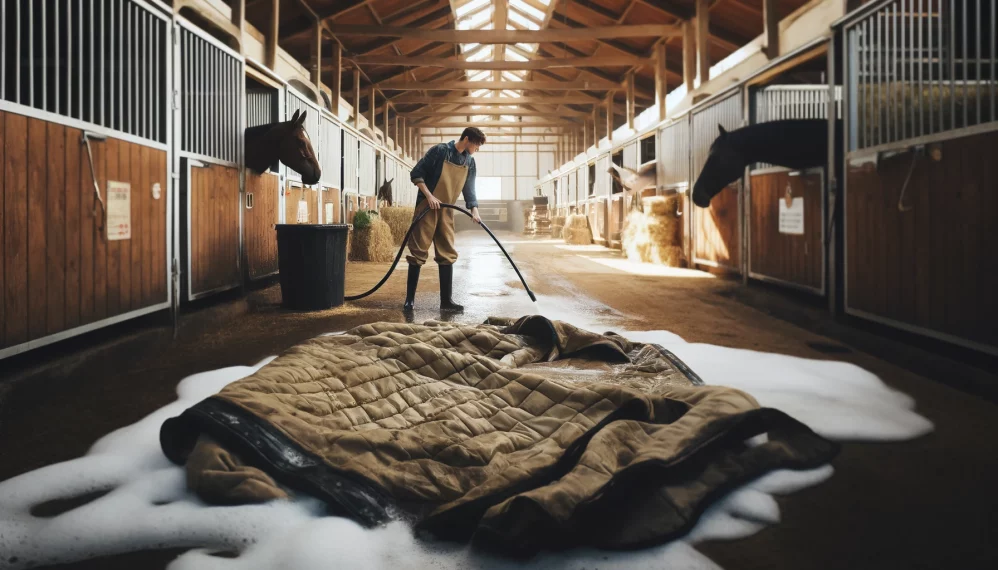
Cleaning a dirty horse blanket is a common challenge for many horse owners. Dirt, sweat, and hair can quickly turn a useful piece of equipment into an unpleasant mess. Cleaning these blankets properly not only keeps your horse comfortable but also extends the life of the blanket. This article offers practical advice on prepping, washing, repairing, and maintaining your horse’s blankets to get them looking and smelling as good as new again.
Key Takeaways
- Cleaning a dirty horse blanket starts with removing dry dirt and using the right detergent for washing.
- You can wash blankets by hand or in a machine, but always follow manufacturer instructions to avoid damage.
- Repair tears quickly and re – waterproof your horse blanket to keep it in good condition.
- Store horse blankets properly after they are completely dry to prevent mold and damage.
Prepping and Washing Horse Blankets
Getting your horse blankets clean starts with the right preparation. Select a suitable detergent and decide if you’ll use a washing machine or hand wash for effective cleaning.
Choosing the right blanket wash
For a clean and comfortable horse blanket, choosing the right wash product is key. Use mild detergents designed for equine blankets. Harsh chemicals can damage the fabric and irritate your horse’s skin.
Look for products that remove dirt without compromising the material’s integrity.
Always check the washing instructions provided by the manufacturer before selecting your detergent. Some blankets may require specific care to maintain their waterproofing and breathability features.
Opting for specialized equine blanket washes ensures thorough cleaning while preserving these essential qualities.
Washing Machine vs. Hand Washing
Once you’ve chosen the right blanket wash, deciding between a washing machine and hand washing is your next step. Each method has its benefits for cleaning horse blankets.
Washing Machine Pros:
- Saves time for busy horse owners.
- Consistent and thorough clean using appropriate cleaners made for waterproof sheets/blankets.
- Myths debunked: Washing in machines won’t ruin blanket waterproofing.
Washing Machine Cons:
- Not all blankets fit in home machines; commercial laundries might be needed.
- Frequent washes could potentially wear out materials over time.
Hand Washing Pros:
- Gentle on fabrics, preserving blanket life.
- Control over wash intensity, protecting sensitive areas.
Hand Washing Cons:
- Time – consuming, demanding physical effort.
- Challenges in thoroughly rinsing large blankets.
Pressure Washing:
- Effective for light maintenance and spot cleaning.
- Quick way to remove mud and loose dirt without full washing.
Choosing Between the Two:
- Consider blanket size and fabric type. Delicate or very large blankets might fare better with hand washing or professional services.
- Think about your time and resources. Busy schedules favor the washing machine, while more free time allows for meticulous hand cleaning.
- Assess the blanket’s condition. Heavily soiled blankets might need the vigorous action of a machine, whereas lighter dirt can easily be handled by hand or pressure washing.
No matter which method you choose, always use cleaners suitable for equine blankets to maintain their condition and waterproofing abilities. Regular cleaning not only keeps your horse healthy but also extends the life of the blanket.
Tips for Hand Washing and Machine Washing
Washing horse blankets properly keeps them in good condition and ensures they last longer. Whether choosing machine washing or a gentle hand wash, using the right techniques is crucial.
- Check the manufacturer’s instructions before cleaning. This step helps you choose between machine washing and hand washing.
- Use a mild detergent designed for horse blankets. These detergents gently clean without damaging the waterproof coating.
- Pre – rinse the blanket to remove loose dirt. You can use a hose or soak it in a large tub of water.
- For machine washing, select a large – capacity washer without an agitator to avoid damage. Use cold water and a gentle cycle.
- Add a cup of vinegar during the rinse cycle when machine washing to cut any soap residue, ensuring no irritants remain on the blanket.
- If hand washing, soak the blanket in a solution of water and mild detergent for about 15 minutes. Then gently scrub dirty areas with a soft brush.
- Rinse thoroughly by hand to make sure all soap is removed. Using cold water is best for rinsing out all detergent effectively.
- Squeeze out excess water gently; do not wring, as it can damage the fabric and affect waterproofing.
- Hang the blanket to dry in a well – ventilated area out of direct sunlight. Ensure it is completely dry before storage to prevent mold and mildew.
Following these tips helps maintain your horse’s blankets clean, keeping them comfortable and protected no matter the weather conditions they face outside.
Repairing and Re-Waterproofing Horse Blankets
Check your horse blankets for tears and fix them quickly to keep them in good shape. Apply new waterproofing treatments to ensure they stay dry and comfortable for your horse.
Identifying and Repairing Damage
Horse blankets that stay wet, dirty, and covered in manure or urine quickly lose their waterproofing. Calling in professionals can solve severe damage issues, as they can repair and re-waterproof the blankets efficiently. Here are steps to identify and fix damage on horse blankets:
- Inspect the blanket closely for any tears, loose threads, or holes. Pay special attention to areas that undergo a lot of stress, like straps and buckles.
- Check waterproofing by sprinkling water on the blanket’s surface. If water doesn’t bead up but soaks in, it needs re-waterproofing.
- For small rips or tears, use a needle and strong thread to sew them up tightly.
- Apply fabric glue to minor nicks or cuts as a quick fix until proper sewing can be done.
- Use patch kits for larger holes. Cut a patch larger than the hole and apply it according to the kit instructions.
- Remove all accessories like leg straps before starting any repair work.
- Clean the area around the tear with mild soap and water before doing any sewing or gluing to ensure a secure hold.
Taking these steps helps in repairing and maintaining horse blankets, restoring their durability and waterproofing qualities against moisture damage.
Re-waterproofing Techniques
Re-waterproofing a horse blanket restores its water repellent feature and ensures the comfort of your horse in wet weather. This process involves applying a waterproofing solution after cleaning the blanket thoroughly. Here’s how to do it effectively:
- Choose the right re-waterproofing product that is safe, wax and silicone-free. This keeps the blanket breathable.
- Wash the blanket thoroughly before re – waterproofing. Dirt and oils can prevent the waterproofing solution from adhering properly.
- Apply the re – waterproofing solution evenly across the entire surface of the freshly washed blanket. Use a sponge for even distribution.
- Allow for proper drying time following application instructions on the product label. Some products may require air drying, while others can handle low heat from a dryer.
- Inspect for even coverage once dry and apply additional coats if necessary. Areas that receive more wear may need more than one coat for effective waterproofing.
- Test the newly applied waterproof layer by sprinkling water on top of the fabric to ensure it beads up rather than soaking in.
Reapplying a protective coating with these re-waterproofing techniques extends your horse blanket’s life span and maintains its effectiveness in keeping your horse dry and comfortable during bad weather.
Importance of Proper Storage
After ensuring your horse blanket is thoroughly re-waterproofed, focusing on proper storage solutions becomes crucial for its care. Storing a muddy or wet horse blanket compromises its fabric and waterproofing capabilities.
Always allow the blanket to air dry completely before putting it away. This step prevents mold, mildew, and damage to the waterproofing material. Placing the dried blanket in a cool, dry area shields it from pests and debris, maintaining its condition for future use.
A properly stored horse blanket maintains its functionality and prolongs its lifespan significantly.
Fabric care involves regular maintenance checks for any signs of wear or tear. Outdoor gear like horse blankets calls for attentive storage practices to keep them ready for their next use.
By adhering to these textile protection strategies, you ensure your equestrian essentials remain in top shape season after season.
Taking Your Dirty Horse Blanket to a Professional Cleaner: Benefits and Options
For horse owners seeking a thorough clean and maintenance for their horse blankets, turning to a professional cleaning service can provide numerous benefits and solve challenges that home washing might not address. Here’s why you might consider a professional cleaner for your horse blankets and what to expect from the service.
Why Choose Professional Cleaning?
- Expertise and Equipment: Professional cleaners have the right tools and knowledge to handle various types of horse blankets, including those with special care instructions. Their industrial machines can accommodate larger blankets that won’t fit in home washers, ensuring a more thorough clean.
- Time-Saving: Busy horse owners can save significant time by outsourcing the cleaning process. Professional cleaners can efficiently handle large volumes or heavily soiled blankets, which might be cumbersome and time-consuming to wash at home.
- Damage Prevention: Using a professional service helps prevent potential damage that can occur from improper home washing techniques. Professionals understand how to maintain waterproofing and breathability features without compromising the fabric integrity.
- Special Treatments: Professional cleaners can also provide re-waterproofing and repair services. This is crucial for extending the life of the blanket and ensuring it continues to protect your horse effectively against the elements.
- Health and Hygiene: A professional clean ensures that all traces of dirt, bacteria, and allergens are removed, which is vital for the health of both the horse and the handler.
Do Dry Cleaners Clean Horse Blankets?
While traditional dry cleaning is not suitable for horse blankets due to the chemicals used and the need to maintain waterproofing features, many professional cleaners offer services specifically tailored for horse blankets. These services typically include washing, drying, and sometimes repairing and re-waterproofing treatments. It’s important to choose a cleaner that specifically advertises as being equipped to handle horse gear to ensure the best care.
Light Maintenance and Preventing Future Damage
Regular care keeps horse blankets in top shape and helps avoid future repairs. Explore more to keep your horse comfortable and protected.
Pressure Washing Techniques
Pressure washing can keep horse blankets in good condition and prevent future damage. Start by using a hard brush in circular motions to work the soap into the blanket. This technique helps to thoroughly clean without harming the waterproofing layer, debunking myths that washing ruins blankets’ protective features.
Experts agree that proper pressure washing plays a crucial role in maintaining the quality of horse blankets. It ensures not only cleanliness but also preserves their functionality for longer use.
Following these steps supports light maintenance efforts significantly, contributing to overall better care for horse equipment.
Products for Light Maintenance
After pressure washing, light maintenance products become essential for keeping the blanket in top condition. For regular cleaning and preventing wear and tear, a stiff brush is ideal for removing surface dirt and maintaining the fabric’s integrity.
Manufacturers suggest using a hose or stiff brush to eliminate excess dirt before it sets in deeply.
For spot treatments and dirt removal, consider specially formulated sprays that are gentle on horse blanket fabrics but tough on stains. These products help in easy upkeep of blankets without causing damage.
Regular use of such cleaners as part of your cleaning routine ensures the longevity of the blankets, saving time and effort by preventing future damage.
Proper care with right products makes all the difference in extending your horse blanket’s life.
Preventative Measures for Future Damage
Preventing future damage to horse blankets saves time and money. Regular maintenance and care keep blankets in good shape for years.
- Clean blankets regularly to remove dirt, sweat, and bacteria. This prevents the material from breaking down prematurely.
- Store blankets in a dry, cool place when not in use. Moist environments encourage mildew growth and rust on metal parts.
- Inspect blankets for wear and tear often. Early repairs can stop small issues from becoming big problems.
- Use a professional cleaning service at least once a year for thorough washing and reproofing. Professionals can also address any damage or wear.
- Apply waterproofing treatments after washing to protect against rain and damp conditions.
- Avoid pressure washing too often as it can weaken the fabric over time. Use this method for excessive dirt only on warm days followed by sunny weather to ensure complete drying.
- Hang blankets properly to dry after every use or cleaning session, avoiding direct sunlight that can fade colors and weaken fibers.
- Implement light maintenance routines such as brushing off loose dirt daily during heavy use periods.
- Follow manufacturer’s instructions for washing and care specific to each blanket type to avoid unintentional damage.
- Encourage air circulation when storing multiple blankets by not packing them too tightly together, reducing the risk of mildew formation.
- Prevent stacking heavy items on top of stored blankets which might crush or misshape them over time.
- Choose detergents carefully; opt for ones specifically designed for horse blanket care to maintain material integrity and waterproofing qualities.
By taking these steps, you ensure your horse’s blankets remain durable, comfortable, and ready to protect against the elements season after season.
Conclusion
Keeping horse blankets clean is essential for equine health and comfort. Start by removing dry debris, then brush, hose, or even use a car wash to get rid of tough dirt before washing.
Choose the right detergent and consider hand washing or using a machine with a protective bag for best results. Fix any damage and re-waterproof your blanket to keep it in top condition.
Regular light maintenance can prevent future issues. Taking these steps ensures your horse stays warm and dry in their well-cared-for blanket, encouraging you to tackle blanket care with confidence.
FAQs
1. What do I need to clean a dirty horse blanket?
You need water, mild detergent, and a brush or sponge.
2. Can I wash a horse blanket in the washing machine?
Yes, if it’s machine-washable; check the label for instructions.
3. How do I dry a horse blanket after washing it?
Hang it outside to air dry completely before storage or use.
4. Should I remove hair and dirt from the blanket before washing?
Yes, brush off all loose hair and dirt for better cleaning results.
5. Can I use bleach on my horse’s blanket?
No, bleach can damage the fabric and irritate your horse’s skin.

